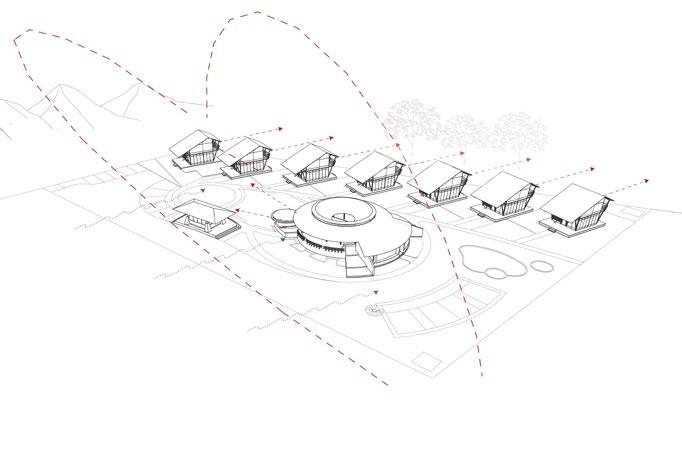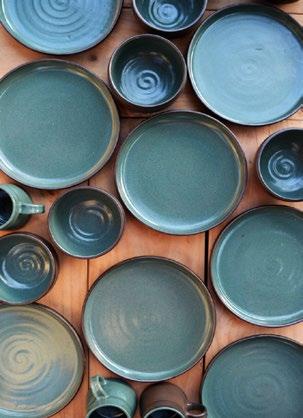
8 minute read
A place for progressive learning A place for progressive learning
Institution in the city of Ahmedabad 2015|Architectural design studio 9 | CEPT university Institution in the city of Ahmedabad 2015|Architectural design studio 9 | CEPT university
Neighbourhood Sanskar Kendra Museum
Advertisement
Tagore memorial Hall Sabarmati River Front National Institue for design
Bimal Patel, HCP, 2002 - This part of the river front is proposed as a Cultural mile including performing arts and museums for design, handicraft and contemporary arts. Built by B.V. Doshi, 1966. Built in collaboration with Mahendra Raj, this brutalist building is a series of rigid frames in reinforced concrete folded plates. The independent internal structure serves 700 people for various important cultural events. Built by Gautum & gira sarabhai,1961 Envisioned by Charles & Ray Eames as an institute to bridge gap between tradition and modernity. Today serves as the finest research and educational institution for design. Built by Le Corbusier, 1954. The museum was envisioned as a part cultural Centre for the city, that had pavilions for subjects like anthropology, natural history, archaeology, monumental sculptures, workshops and depots, folklores in open air. Out of the larger plan only the museum was built. These eminent complexes are housed within the residential area , which comprises of low storey-ed middle income group appartments
“Crafts and culture” are often synonymous with the city of Ahmedabad, and India at large. Its marginalization has often been talked of in the light of the complex growing economic, social and technological matrix. There is a need for a crossfunctional and multidisciplinary collaboration between designers and craftsmen devising strategic and holistic solutions to support competitiveness.
The proposed intervention comprises of a formal institution that serves as a platform for collaboration between craftsmen and designers along with public spaces that facilitate engagement of the city with crafts and material culture at varied scales becoming a catalyst of progressive learning for the city at large.
The intervention is strategically anchored around the culturally significant public complexes Sanskar Kendra and Tagore hall, the National School of Design across the road and the river front development.
Site of intervention
The Inward descend
A place of worship for the community of Tanaf valley Senegal, Africa. 2015|Architectural design competition|Kaira looro
The aim of the competition is to create a place for worship, which becomes a symbol for the territory and help communities to overcome difficulties.
2 2
Atlantic ocean
r i v e r c a s a m a n c e
The site of intervention is located in the village of Tanaf, that overlooks a valley called Tanaf Bolong. The Water that runs from the Atlantic Ocean run through the Casamance river to the valley, has a salt concentration which is five times than the ocean’s one. The salt intrusion and drought affects the people of villages and communities who live in the valley. Tanaf village Tanaf being the main village of the river basin on the Tanaf Bolong Valley has a population of 4000 residents, a mix of Muslims and Christians. The village houses a number of public buildings i.e., school, markets, a church and a mosque, but most of these are in poor condition.

Proposed intervention : The step well
For peace to prevail, it is important to set one’s mind away from the essentials. The proposed intervention in the form of a step well, harvests rainwater for the community and allows places of worship, congregation markets and performances. It pivots around the utilitarian need while providing increased solitude in spaces within the earth which contradicts notion of the hot landscape and the condition of scarcity. The aim is to make a landmark in the minds, and not in space.
Under the trees
Vegetable plantation Seating under the tree Seating cum dining is created under a 150 yr old neem tree, Adjoining the kitchen
Fruit plantation Seasonal plantation Outdoor Kitchen Tool room & Public toilet Executed by local villagers after Skill transfer with skilled artisans.
Lily Pond Formed due to the excavation of soil for the rammed earth walls of the house.

Lawns Spill out of the house acts as the main gathering space.
Second Approach From Jaspur village Amphitheater Situated in the low-lying shaded on site, acts as a gathering space, and a catchment for the percolation pit during wet season
Bamboo Plantation for Retaining soil Main approach From river Vishwamitri Caretaker’s Residence Water Tank Situated at the highest point of the site
The House A single occupancy house, elevated from the valley, having minimal contact on the ground, leaving the natural flow of site undisturbed. The house is approached from the south-west i.e. the lawns.
Stabilized Earth walkway along the entire site
Weekend home Outskirts of Vadodra , Gujarat 2018 - ongoing | Independent project
Situated in the Outskirts of Vadodra, set amidst vast farmlands and large trees, measuring about 6500 sq. yards; the site is accessible from both the north-west and south-east. It’s main entrance comes from the river and the other from the village. The undulated landscape of the site is formed due to the flow of water over the years through the site.
The brief of the project was to develop the site into a space that facilitates engagement with farming and activates outdoor activities amidst nature along a minimal house for a single user or a couple, who’d stay here away from the growing city, and practice organic farming on a small scale. The place also anticipates an occasional social gathering in the outdoors. The challenge was to address the above requirements with a minimal impact on the natural processes on site.
1. The house is minimally scaled, and is elevated from the ground to leave the water flow undisturbed.
2. Percolation pits and bamboo plantations are strategically positioned, to collect water and prevent further surface run off.
The glamping refuge
A stay for Nature enthusiasts and ornithologists Pavagadh, Gujarat, India 2019 - ongoing | Independent project
Agricultural Land
Parking

Forest Reserve
Open air amphitheater

Common kitchen and dining Semi open bamboo structure stone enclosure for the kitchen Independent cottages 7 cottages overlooking the forest Bamboo structure wattle and daub walls
Champaner UNESCO Site
Forest Reserve

Site
Pavagadh hills
The site is set amidst large patches of agricultural land, adjoining government forest reserve and is located in close vicinity of UNESCO world heritage site of Champaner, the archaeological park and the Pavagadh hills.
The region being rich and diverse in flora and Fauna, invites large numbers of nature enthusiasts. The site sharing its boundaries with the forest reserve, the brief was to design a campus to house 7 independent cottages, dormitories and common facilities for ornithologists and other nature enthusiasts.
Administration block Agricultural land Dormitory block Water body Lowest point on the site
Agricultural land
Cottages are oriented North south The lean to roof towards the south, protects from the harsh summer sun, The north double volume opens to the forest and also ensure natural light.
The cottages adjacently placed, with openings only on the north and south protects from the horizontal west sun and ensures privacy.
Considering ecological sensitivity of the zone and the brief the major considerations for the project were: 1. The structures are carefully designed and built in bamboo and earth, to minimize the impact on the natural setting as well as creating opportunities to engage with it.
Apart from adopting the sustainable building choices, the project appreciates and strengthen social relations, i.e. project employs skilled artisans along with local villagers generating employment for the villagers by skill transfer on site through the building practices and landscaping.
Mural inspired by Kandinsky’s painting Size: 60 cm x 60 cm ;20 pieces Materials: Stoneware clay, Wood Technique: Throwing,Hand-building Raku Firing


Tall bottles Size: 45 - 60 cm Materials: Stoneware, iron oxides, sawdust Technique: Wheel thrown, Barrel Fired
High fired Functional-ware and sculptures 2017 |Apprentice|Golden Bridge Pottery, Pondicherry 2018|Studio Assistant|Aavartan Pottery Studio, Auroville 2019 -|Independent commissioned works|doro, Ahmedabad

“doro” signifies the thread used to separate the pot from the wheel. It also translates to clay and earth in Japanese. Traces of their techniques and philosophies can be felt in the works.
Tall containers Materials: Stoneware Technique: Wheel throwing, Wood firing 1280 degrees



Shifting identities, Indian Ceramic Triannale 2018, Jawahar Kala Kendra, Jaipur. Assitant to Ceramicist Rakhee kane in System Design, Making, Firing and erecting on site. 180 modules : 400mm x 400mm each Materials: Ceramic wall: Stone ware clay body, Shino glaze, Metal structure Rammed earth wall: Varied soils around site, Sand, lime. Technique: Hand-building, Wood-firing
Table ware Materials :Stoneware Technique: Wheel throwing,Gas firing 1280 degrees


